Press Releases
Euroseas Ltd. Reports Results for the Quarter Ended March 31, 2012
Maroussi, Athens, Greece - May 15, 2012 - Euroseas Ltd. (NASDAQ: ESEA), an owner and operator of drybulk and container carrier vessels and provider of seaborne transportation for drybulk and containerized cargoes, announced today its results for the three month period ended March 31, 2012.
First Quarter 2012 Highlights:
·Net loss of $9.0 million or $0.29 loss per share basic and diluted on total net revenues of $13.9 million. Excluding the effect of unrealized gain and realized losses on derivatives, unrealized gain on trading securities and loss on sale of vessel, the loss for the period would have been $0.1 million, or $0.00 loss per share.
·Adjusted EBITDA was $4.9 million. Please refer to a subsequent section of the Press Release for a reconciliation of adjusted EBITDA to net loss.
·An average of 15.92 vessels were owned and operated during the first quarter of 2012 earning an average time charter equivalent rate of $11,258 per day.
·Declared a quarterly dividend of $0.04 per share for the first quarter of 2012 payable on June 13, 2012 to shareholders of record on June 4, 2012. This is the twenty-seventh consecutive quarterly dividend declared.
Aristides Pittas, Chairman and CEO of Euroseas commented: "The first quarter of 2012 proved to be a quite challenging one as the containership market remained low throughout the quarter resulting in lower renewal rates for those of our vessels which had their charters expire and delays in finding employment. On the other hand, the drybulk market, although also depressed, did not affect our revenues during the first quarter as our vessels are chartered well into 2013. While we remain concerned about the near term prospects of the drybulk market, we believe the container ship market may have bottomed and even commenced to turn as indicated by the increase in the freight indices and the reduction of the number of vessels laid-up, of course, depending on the overall economic developments.
On the investment front, we believe that the depressed charter markets will result in very attractive investment opportunities, especially, in the drybulk sector in which the supply of vessels is set to grow throughout the year; but also, in the containership sector. In fact, we took advantage of two such opportunities in the containership sector by acquiring one and agreeing to acquire one more containership through our joint venture with two private equity firms, Euromar LLC, which now owns 10 vessels.
To increase our funds available to acquire additional and younger tonnage at the present depressed market conditions, we sold one of our older containerships, and furthermore, our Board decided to raise additional funds via a rights offering to our shareholders, the specific terms of which will be announced shortly. We believe that the latter is the most effective way for us to access additional funds without dilution to our shareholders.
In view of the above plans, our Board decided to decrease our quarterly dividend to $0.04 per share which represents a yield of about 11% on the basis of our stock price on May 14, 2012."
Tasos Aslidis, Chief Financial Officer of Euroseas commented: "The results of the first quarter of 2012 primarily reflect the loss we incurred from the sale of M/V Jonathan P; in addition to this loss, the quarter's result was influenced by the poor containership market which, in turn, resulted in idle days for two of our ships. During the first quarter of 2012, we had significant contributions to our revenues from our drybulk fleet which is chartered at above current market rate levels. Our results for the quarter were also negatively influenced by losses on our interest rate swap contracts.
Total daily vessel operating expenses, including management fees and general and administrative expenses, during the first quarter of 2012 increased by less than 1% on a per vessel per day basis compared to the first quarter of 2011. This increase mainly reflects higher general and administrative expenses. Our drydocking expenses in the first quarter of 2012 were minimal on a per vessel per day basis as compared to the first quarter of 2011. We believe that we continue to maintain one of the lowest operating cost structures amongst the public shipping companies which is one of our competitive advantages.
As of March 31, 2012, our outstanding debt is about $70.4 million versus restricted and unrestricted cash of about $35.7 million. We were in compliance with all our loan covenants."
First Quarter 2012 Results:
For the first quarter of 2012, the Company reported total net revenues of $13.9 million representing a 2.1% decrease over total net revenues of $14.2 million during the first quarter of 2011. The Company reported losses for the period of $9.0 million as compared to a net loss of $0.6 million for the first quarter of 2011. The results for the first quarter of 2012 include a $0.2 million unrealized gain on derivatives and trading securities as compared to $0.5 million net unrealized gain on derivatives and trading securities for the same period of 2011; and, a $0.4 million realized loss on derivatives versus a $0.2 million realized loss in the same period of 2011. Drydocking expenses of $0.03 million during the quarter were lower than the $1.5 million incurred in the first quarter of 2011 and refer to expenses for our last vessel drydocked in the fourth quarter of 2011. Depreciation expense for the first quarter of 2012 was $4.5 million compared to $4.6 million during the same period of 2011. On average, 15.92 vessels were owned and operated during the first quarter of 2012 earning an average time charter equivalent rate of $11,258 per day compared to 16 vessels in the same period of 2011 earning on average $11,088 per day.
Adjusted EBITDA for the first quarter of 2012 was $4.9 million, a 31.8% increase from $3.7 million achieved during the first quarter of 2011. Please see below for Adjusted EBITDA reconciliation to net loss and cash flow provided by operating activities.
Basic and diluted loss per share for the first quarter of 2012 was $0.29, calculated on 31,167,211 weighted average number of shares outstanding compared to basic and diluted loss per share of $0.02 for the first quarter of 2011, calculated on 31,002,211 weighted average number of shares outstanding.
Excluding the effect on the loss for the quarter of the unrealized gain and realized losses on derivatives, unrealized gain on trading securities and the loss on sale of vessel, the loss per share for the quarter ended March 31, 2012 would have been $0.00 per share basic and diluted, compared to the loss, for the quarter ended March 31, 2011 of $0.04 per share basic and diluted. Usually, security analysts do not include the above items in their published estimates of earnings per share.
Fleet Profile:
The Euroseas Ltd. fleet profile is as follows:
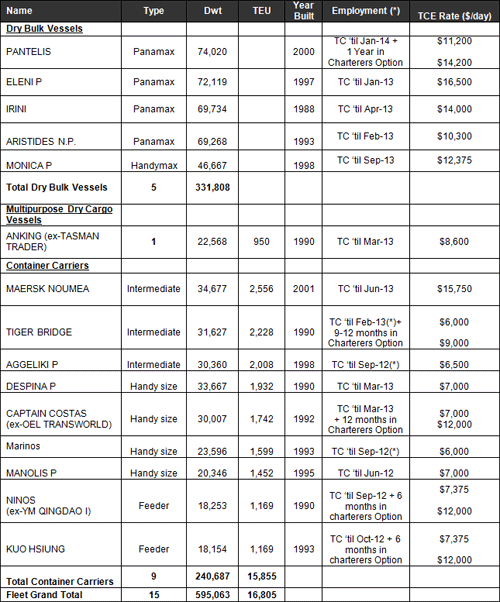
Note: Charter duration indicates the earliest redelivery date unless the contract rate is lower than the current market rate in which cases the latest redelivery date is assumed; vessels with the latest redelivery date shown are marked by (*). Generally, charterers have a range of 15 days to 3 of months to redeliver the vessels depending on the length of the charter.
Summary Fleet Data:
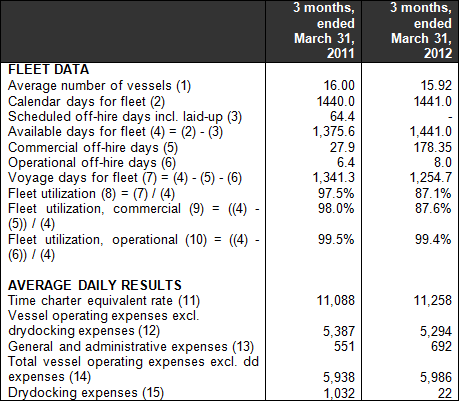
(1) Average number of vessels is the number of vessels that constituted our fleet for the relevant period, as measured by the sum of the number of calendar days each vessel was a part of our fleet during the period divided by the number of calendar days in that period.
(2) Calendar days. We define calendar days as the total number of days in a period during which each vessel in our fleet was in our possession including off-hire days associated with major repairs, drydockings or special or intermediate surveys or days of vessels in lay-up. Calendar days are an indicator of the size of our fleet over a period and affect both the amount of revenues and the amount of expenses that we record during that period.
(3) The scheduled off-hire days including vessels laid-up are days associated with scheduled repairs, drydockings or special or intermediate surveys or days of vessels in lay-up. The shipping industry uses available days to measure the number of days in a period during which vessels were available to generate revenues.
(4) Available days. We define available days as the total number of days in a period during which each vessel in our fleet was in our possession net of scheduled off-hire days including days of vessels laid-up.
(5) Commercial off-hire days. We define commercial off-hire days as days waiting to find employment.
(6) Operational off-hire days. We define operational off-hire days as days associated with unscheduled repairs or other off-hire time related to the operation of the vessels.
(7) Voyage days. We define voyage days as the total number of days in a period during which each vessel in our fleet was in our possession net of commercial and operational off-hire days. The shipping industry uses voyage days to measure the number of days in a period during which vessels actually generate revenues.
(8) Fleet utilization. We calculate fleet utilization by dividing the number of our voyage days during a period by the number of our available days during that period. The shipping industry uses fleet utilization to measure a company's efficiency in finding suitable employment for its vessels and minimizing the amount of days that its vessels are off-hire for reasons such as unscheduled repairs or days waiting to find employment.
(9) Fleet utilization, commercial. We calculate commercial fleet utilization by dividing our available days net of commercial off-hire days during a period by our available days during that period.
(10) Fleet utilization, operational. We calculate operational fleet utilization by dividing our available net of operational off-hire days during a period by our available days during that period.
(11) Time charter equivalent, or TCE, is a measure of the average daily revenue performance of a vessel on a per voyage basis. Our method of calculating TCE is consistent with industry standards and is determined by dividing revenue generated from voyage charters net of voyage expenses by voyage days for the relevant time period. Voyage expenses primarily consist of port, canal and fuel costs that are unique to a particular voyage, which would otherwise be paid by the charterer under a time charter contract. TCE is a standard shipping industry performance measure used primarily to compare period-to-period changes in a shipping company's performance despite changes in the mix of charter types (i.e., spot voyage charters, time charters and bareboat charters) under which the vessels may be employed between the periods.
(12) Daily vessel operating expenses, which include crew costs, provisions, deck and engine stores, lubricating oil, insurance, maintenance and repairs and management fees are calculated by dividing vessel operating expenses by fleet calendar days for the relevant time period. Drydocking expenses are reported separately.
(13) Daily general and administrative expense is calculated by dividing general and administrative expense by fleet calendar days for the relevant time period.
(14) Total vessel operating expenses, or TVOE, is a measure of our total expenses associated with operating our vessels excluding drydocking expenses. TVOE is the sum of vessel operating expenses and general and administrative expenses. Daily TVOE is calculated by dividing TVOE by fleet calendar days for the relevant time period.
(15) Drydocking expenses, which include expenses during drydockings that would been capitalized and amortized under the deferral method divided by the fleet calendar days for the relevant period. Drydocking expenses could vary substantially from period to period depending on how many vessels underwent drydocking during the period.
Conference Call and Webcast:
Tomorrow, Wednesday, May 16, 2012 at 9:30 a.m. EDT, the company's management will host a conference call to discuss the results.
Conference Call details:
Participants should dial into the call 10 minutes before the scheduled time using the following numbers: 1 866 819 7111 (from the US), 0800 953 0329 (from the UK) or +44 (0)1452 542 301 (from outside the US.) Please quote "Euroseas".
A recording of the conference call will be available until May 23, 2012 by dialing 1 866 247 4222 (from the US), 0800 953 1533 (from the UK) or +44 (0)1452 550 000 (the standard international replay number). Access Code: 6973591#
Audio webcast - Slides Presentation:
There will be a live and then archived audio webcast of the conference call, via the internet through the Euroseas website (www.euroseas.gr). Participants to the live webcast should register on the website approximately 10 minutes prior to the start of the webcast. A slide presentation on the First Quarter 2012 results in PDF format will also be available 30 minutes prior to the conference call and webcast accessible on the company's website (www.euroseas.gr) on the webcast page. Participants to the webcast can download the PDF presentation.
Consolidated Condensed Statements of Comprehensive Loss
(All amounts expressed in U.S. Dollars except number of shares)
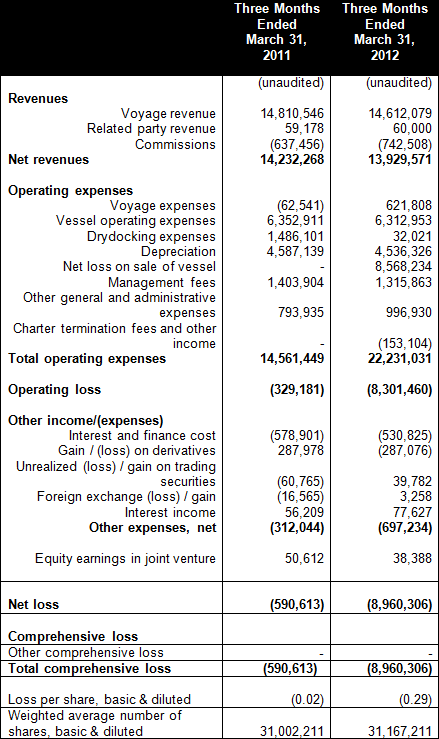
Euroseas Ltd.
Consolidated Condensed Balance Sheets
(All amounts expressed in U.S. Dollars - except number of shares)
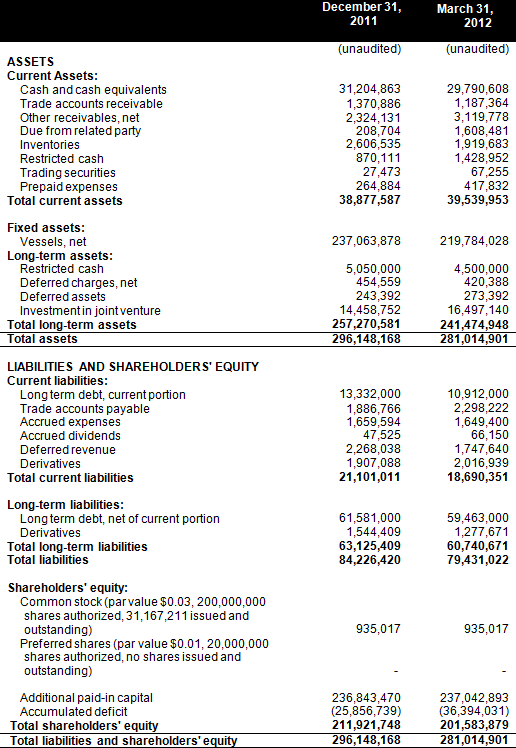
Euroseas Ltd.
Consolidated Condensed Statements of Cash Flows
(All amounts expressed in U.S. Dollars)
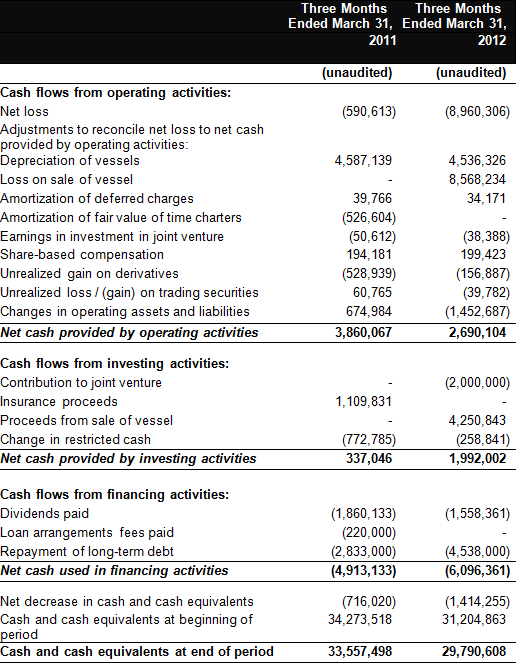
Euroseas Ltd.
Reconciliation of Adjusted EBITDA to
Net Loss and Cash Flow Provided By Operating Activities
(All amounts expressed in U.S. Dollars)
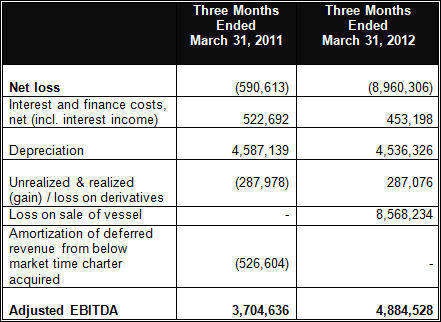
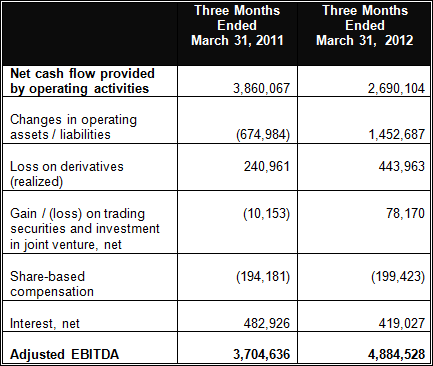
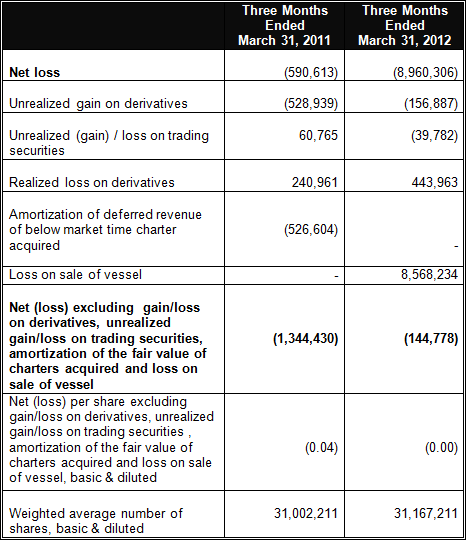
Euroseas Ltd. was formed on May 5, 2005 under the laws of the Republic of the Marshall Islands to consolidate the ship owning interests of the Pittas family of Athens, Greece, which has been in the shipping business over the past 136 years. Euroseas trades on the NASDAQ Global Select Market under the ticker ESEA.
Euroseas operates in the dry cargo, drybulk and container shipping markets. Euroseas' operations are managed by Eurobulk Ltd., an ISO 9001:2008 certified affiliated ship management company, which is responsible for the day-to-day commercial and technical management and operations of the vessels. Euroseas employs its vessels on spot and period charters and through pool arrangements.
The Company has a fleet of 15 vessels, including 4 Panamax drybulk carriers and 1 Handymax drybulk carrier, 3 Intermediate containership, 4 Handysize containerships, 2 Feeder containerships and a multipurpose dry cargo vessel. Euroseas` 5 drybulk carriers have a total cargo capacity of 331,808 dwt, its 9 containerships have a cargo capacity of 15,855 teu and its multipurpose vessel has a cargo capacity of 22,568 dwt or 950 teu.
About Euromar LLC
Euromar LLC, formed on March 25, 2010, is a joint venture of Euroseas with companies managed by Eton Park Capital Management ("Eton Park") and Rhône Capital ("Rhône"), two recognized private investment firms to form Euromar LLC, a Marshall Islands limited liability company. Eton Park's investments are made through Paros Ltd., a Cayman Islands exempted company, and Rhône's investments are made through the Cayman Islands limited companies All Seas Investors I Ltd., All Seas Investors II Ltd., and the Cayman Islands exempted limited partnership All Seas Investors III LP. Pursuant to the terms of the Joint Venture, Euroseas would invest up to $25.0 million for a 14.28% interest in the Joint Venture, while Eton Park and Rhône would each invest up to $75.0 million for a 42.86% interest each in the Joint Venture, for a total of $175.0 million. Euroseas has contributed $17.0 million of its $25.0 million commitment to-date.
Forward Looking Statement
This press release contains forward-looking statements (as defined in Section 27A of the Securities Act of 1933, as amended, and Section 21E of the Securities Exchange Act of 1934, as amended) concerning future events and the Company's growth strategy and measures to implement such strategy; including our expected joint venture and vessel acquisitions and time charters. Words such as "expects," "intends," "plans," "believes," "anticipates," "hopes," "estimates," and variations of such words and similar expressions are intended to identify forward-looking statements. Although the Company believes that the expectations reflected in such forward-looking statements are reasonable, no assurance can be given that such expectations will prove to have been correct. These statements involve known and unknown risks and are based upon a number of assumptions and estimates that are inherently subject to significant uncertainties and contingencies, many of which are beyond the control of the Company. Actual results may differ materially from those expressed or implied by such forward-looking statements. Factors that could cause actual results to differ materially include, but are not limited to changes in the demand for drybulk vessels and containerships, competitive factors in the market in which the Company operates; risks associated with operations outside the United States; and other factors listed from time to time in the Company's filings with the Securities and Exchange Commission. The Company expressly disclaims any obligations or undertaking to release publicly any updates or revisions to any forward-looking statements contained herein to reflect any change in the Company's expectations with respect thereto or any change in events, conditions or circumstances on which any statement is based.
Visit our website www.euroseas.gr
Company Contact
Tasos Aslidis
Chief Financial Officer
Euroseas Ltd.
11 Canterbury Lane,
Watchung, NJ 07069
Tel. (908) 301-9091
E-mail: aha@euroseas.gr
Investor Relations / Financial Media
Nicolas Bornozis
President
Capital Link, Inc.
230 Park Avenue, Suite 1536
New York, NY 10169
Tel. (212) 661-7566
E-mail: euroseas@capitallink.com
